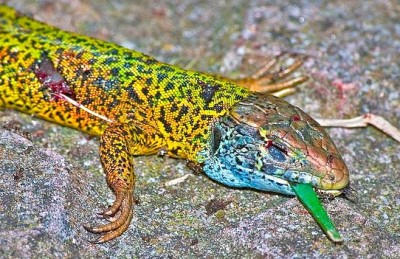How Do You Know if a Lizard Is Dead
Introduction
Although medical knowledge has answered many questions regarding animal life, there are nevertheless many mysteries that face up us. And nowhere is the mystery of life and expiry more than apparent than when dealing with reptiles (Fig 1).

Figure 1. This lizard appears to be expressionless, simply is it? How can the veterinarian verify life (and expiry) in reptiles? Image by Eric Caballero.
Detecting the reptile eye rate
- Stethoscope: Even in the active, healthy reptile the stethoscope is generally a useless piece of equipment. The presence of scales or the shell makes auscultation of the heart difficult, if non incommunicable, in many instances. Therefore ancillary testing such as ultrasonography or electrocardiography is required.
- Doppler or ultrasound: A pediatric Doppler probe or ultrasound probe tin can be used to detect arterial blood menstruation. Place the Doppler probe direct over the apex beat out or an accessible artery. Utilize Doppler gel to heighten contact between the probe and the skin.
- Electrocardiogram (ECG): Alligator clips tin be placed directly on the reptile'due south leathery skin or scales, yet recording potentials can be enhanced by attaching ECG clips to fine gauge hypodermic needles that have been placed in the advisable locations. Loops of stainless steel suture can also be used as subcutaneous leads only this practice is most unremarkably elected for coldhearted monitoring.
Brain death versus cardiac arrest
Unfortunately ECG or Doppler readings can be misleading when verifying death in the reptile patient. Encephalon death can (evidently) precede asytole by many hours considering the middle sometimes continues to trounce and the trunk can continue to writhe for many hours later encephalon activity has ceased. Alternatively the heart rate can boring so dramatically that the "reptile'southward centre charge per unit tin can change from beats per minute to minutes per beat…" (Mader 2006).
All reptile vets have a story similar this…
Checking heart rate is simply ONE part of the film when verifying reptile death. All reptile veterinarians have a story of a "expressionless" patient that wakes up 24 hours after—often with cypher more than fourth dimension or supplemental estrus provided.
…Last dark on emergency I get a 6-year old 50-lb tortoise, which had been "basking" at the bottom of the pool for virtually 3 hours. Owners upset, 'attempt everything' kind of situation. Then the tortoise is room temperature, not breathing, flaccid, no deep pain– hook upward the ECG, no electrical activity. I option up the tortoise; hold it upside down and well-nigh one-half a gallon of h2o comes pouring out. Not good.
…It gets busy, and about 2 hours subsequently I hear this deep grunting sound. There's a couple of critical animals in the hospital, and then I go worried and look around – nothing. A few minutes afterwards the same thing happens – and I wait downwardly to find the tortoise chewing on his ET tube!
…At present he's getting pissed – poked and prodded quite a few times, and I tin can't even incorporate him in a cage, he'southward so restless. Call the owners – they pretty much fall over themselves when I tell them to pick the tortoise upwards. Makes me look similar a champ, while honestly didn't do much more than give it a good-natured whirl… goes to show, you never know how [a reptile will] turn out. —Thou.Dekker, DVM; EBVE, Antioch, CA
There'due south no heart beat out, now what…?
Later on euthanizing a reptile or proclaiming a reptile (probably) expressionless, merely Earlier sending the patient home or performing a necropsy it is imperative to confirm (or ensure) that the animal is dead.
- Reptile muscles go through yet stages of death seen in other species: primary relaxation or flaccidity, rigor mortis or rigidity, followed past secondary relaxation. Then if the beast appears to be in rigor it is likely dead (exist sure to rule out tetany).
- Some other rule of thumb when dealing with euthanized or dying reptiles is to wait 12 or preferably 24 hours later on euthanasia to send the animal domicile with the owners.
- Adjunct procedures tin can also be performed to ensure death in a reptile AFTER euthanizing the animate being and/or non detecting a centre charge per unit.
- Decapitation with transection of the cervical spinal cord or pithing the encephalon is often performed before necropsy (and Later euthanasia)
- Some clinicians elect to place the reptile in the freezer AFTER euthanasia and not detecting a heart rate. Note: Freezing alone is NOT considered an adequate method for euthanasia of Any species (AVMA 2007).
Visit Reptile Wild fauna Euthanasia Techniques for more detailed information.
Summary
In conclusion, there is no 100% reliable mode to verify death in reptiles brusque of putrification or decapitation. For this reason, reptile veterinarians routinely wait 12 to 24 hours after declaring the creature deceased before releasing the body. Adjunct procedures, such every bit freezing, pithing, and decapitation, are besides routinely performed equally needed after euthanasia and after failure to detect a heartbeat.
References
References
AVMA. AVMA Panel on Euthanasia. June 2007. Pp. 17-20. Available at https://www.avma.org/KB/Policies/Documents/euthanasia.pdf. Accessed on October 24, 2012.
Dekker Yard. Drowned tortoise with no vital signs was successfully revived. Veterinary Data Network website. Available at http://www.vin.com/Members/boards/discussionviewer.aspx?FirstMsg=1&LastMsg=20&DocumentId=3580842. Last updated: 9/11/07. Accessed on Oct 22, 2012.
Johnson A, Clinton J, Stevens R. Turtle heart beats five days subsequently death. Amer Biol Instructor 19(6):176-177, 1957.
Mader DR. Euthanasia. In: Mader DR (ed). Reptile Medicine and Surgery, 2nd edition. Saunders Elsevier; St. Louis: 2006. Pp. 564-568.
To cite this page:
Pollock C. How to verify life (and death) in reptiles. October 22, 2012. LafeberVet Web site. Available at https://lafeber.com/vet/how-to-verify-life-and-death-in-reptiles/
holbrookpeatchath.blogspot.com
Source: https://lafeber.com/vet/how-to-verify-life-and-death-in-reptiles/
0 Response to "How Do You Know if a Lizard Is Dead"
Post a Comment